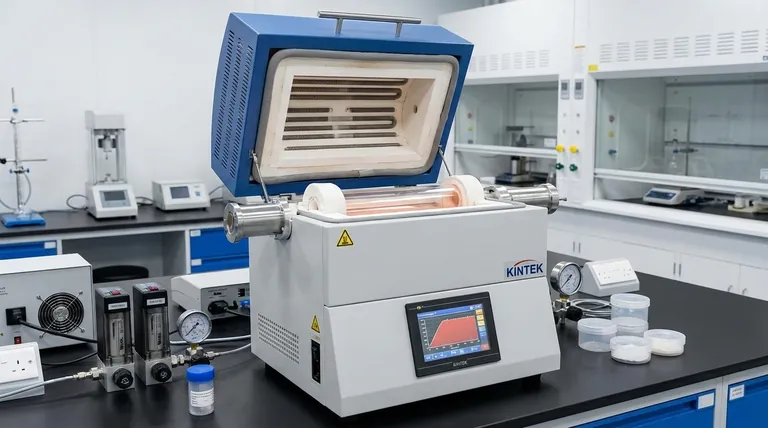For high-temperature applications, several types of furnaces are used, most notably continuous furnaces, batch furnaces (like box and tube furnaces), and vacuum furnaces. These furnaces are specifically engineered to operate consistently at extreme temperatures, typically defined as being between 1400°C and 1800°C, to meet the demands of industrial and laboratory processes.
The critical distinction between high-temperature furnaces is not just the temperature they reach, but how they process materials. The choice depends entirely on your production volume and whether the material requires a controlled atmosphere.

What Defines a High-Temperature Furnace?
To understand which furnace to use, we must first define the category. High-temperature operation is a demanding engineering challenge that requires specialized design.
The Critical Temperature Range
A furnace is generally considered "high-temperature" when it is designed to operate reliably in the 1400°C (2552°F) to 1800°C (3272°F) range. Sustaining these temperatures requires advanced materials for insulation and heating elements.
The Importance of Process
The term "process temperature" refers to the maximum temperature at which a furnace can operate while maintaining its rated performance and ensuring product quality. This is the most important metric for any high-temperature application.
Core Furnace Types Based on Production Flow
The most fundamental decision in selecting a furnace is matching its operational design—batch or continuous—to your production needs.
Batch Furnaces for Low-Volume and R&D
For low-volume production, research, or processes requiring high precision on individual parts, a batch furnace is the standard. Products are loaded in, heated, and removed in discrete cycles.
Common examples of batch furnaces include box furnaces, which offer a large chamber for various parts, and tube furnaces, which provide excellent temperature uniformity for smaller samples.
Continuous Furnaces for High-Volume Manufacturing
When medium or high-volume production is required, a continuous furnace is necessary. These systems are designed to maintain a constant temperature while products move through them on a conveyor.
This approach ensures exceptional uniformity and process repeatability, making it highly efficient for industrial-scale thermal treatments.
Specialized Furnaces and Configurations
Beyond the production flow, the processing environment is a critical factor that dictates the use of more specialized equipment.
Vacuum Furnaces for Controlled Atmospheres
A vacuum furnace is used when the material being processed cannot be exposed to the air. By removing the atmosphere, it prevents oxidation and other reactions that would occur at high temperatures.
This is essential for processing reactive metals, brazing, and certain heat-treating applications where material purity is paramount.
Custom Furnaces for Unique Requirements
For highly specialized applications that standard models cannot accommodate, a custom furnace may be required. These are designed and built to meet the unique thermal and material handling needs of a specific project.
Understanding the Trade-offs
Selecting a furnace involves balancing performance, flexibility, and cost. Each type comes with distinct advantages and disadvantages.
Batch vs. Continuous: Flexibility vs. Throughput
Batch furnaces offer maximum flexibility to change temperatures and processes, making them ideal for labs and custom job shops. However, their throughput is limited.
Continuous furnaces deliver superior efficiency and consistency for mass production but represent a significant capital investment and are inflexible for varied processes.
Atmosphere vs. Air: Simplicity vs. Purity
Standard furnaces that operate in ambient air are simpler and less costly. However, they are unsuitable for materials that oxidize.
Vacuum furnaces provide ultimate control over the processing environment but add significant complexity, cost, and longer cycle times due to the need to pump down the chamber.
Making the Right Choice for Your Application
Your choice must be guided by a clear understanding of your process goals. The furnace is a tool, and you must select the right one for the job.
- If your primary focus is high-volume manufacturing: A continuous furnace is the most efficient and repeatable solution.
- If your primary focus is research, development, or low-volume batches: A batch furnace, such as a box or tube furnace, provides the necessary operational flexibility.
- If your primary focus is processing air-sensitive materials: A vacuum furnace is the only choice to ensure a controlled, non-oxidizing atmosphere.
Ultimately, defining your required temperature, production volume, and atmospheric conditions will lead you to the most effective furnace technology.
Summary Table:
| Furnace Type | Ideal For | Key Characteristic |
|---|---|---|
| Batch Furnace | R&D, Low-Volume, Flexibility | Processes materials in discrete cycles |
| Continuous Furnace | High-Volume Manufacturing | Constant temperature with conveyor-based flow |
| Vacuum Furnace | Air-Sensitive Materials | Controlled, non-oxidizing atmosphere |
Struggling to select the right high-temperature furnace for your lab's specific process? KINTEK specializes in lab equipment and consumables, providing expert guidance to match you with the ideal batch, continuous, or vacuum furnace. We ensure you get the precise temperature control, atmosphere management, and throughput your research or production demands. Contact us today via our [#ContactForm] to discuss your application and receive a personalized solution!
Visual Guide

Related Products
- 1400℃ Laboratory Quartz Tube Furnace with Alumina Tube Tubular Furnace
- Laboratory Muffle Oven Furnace Bottom Lifting Muffle Furnace
- 2200 ℃ Graphite Vacuum Heat Treat Furnace
- Molybdenum Vacuum Heat Treat Furnace
- Vertical High Temperature Graphite Vacuum Graphitization Furnace
People Also Ask
- How does a tubular furnace work? A Guide to Controlled High-Temperature Processing
- What precautions should be taken when using a tube furnace? Ensure Safe, Effective High-Temperature Processing
- What materials are used for the tubes in tube furnaces? A Guide to Selecting the Right Tube for Your Process
- What is a tubular furnace used for? Precision Heating for Material Synthesis & Analysis
- What is a tube furnace used for? Achieve Precise, Controlled Thermal Processing



















